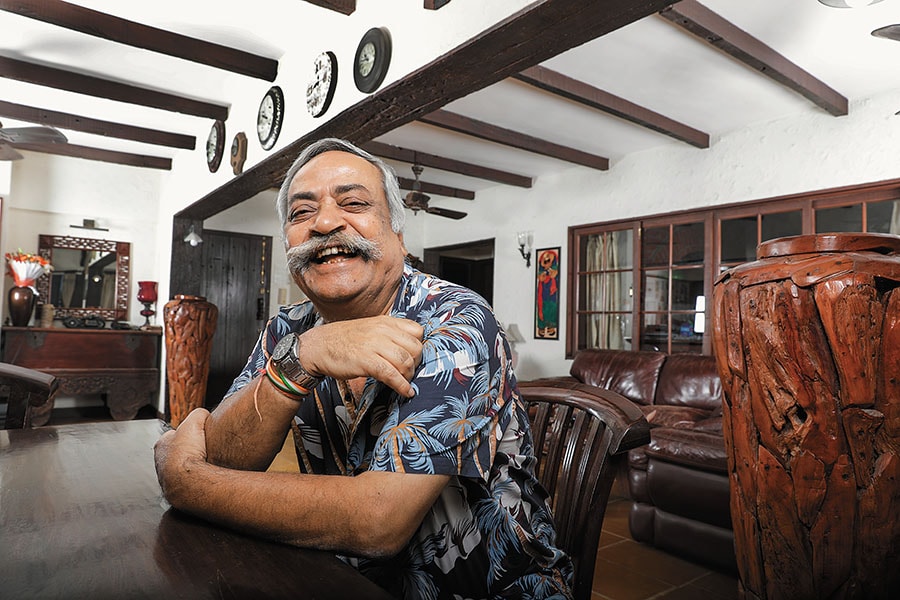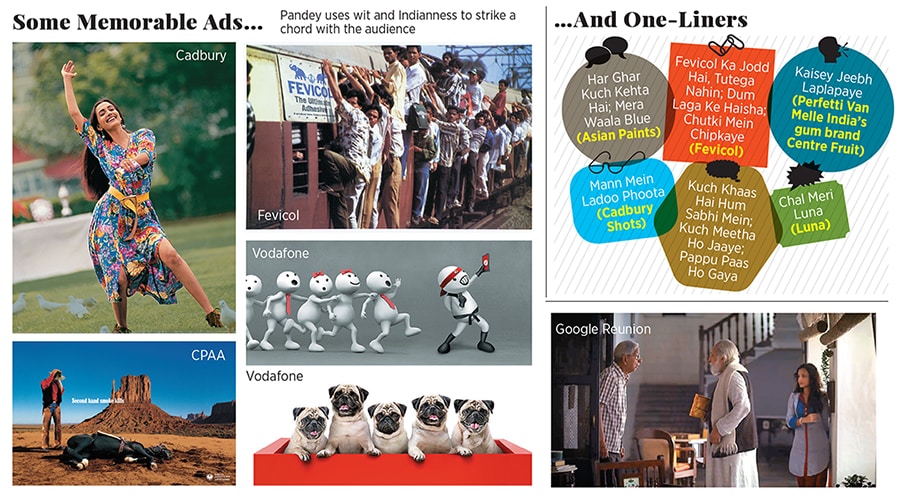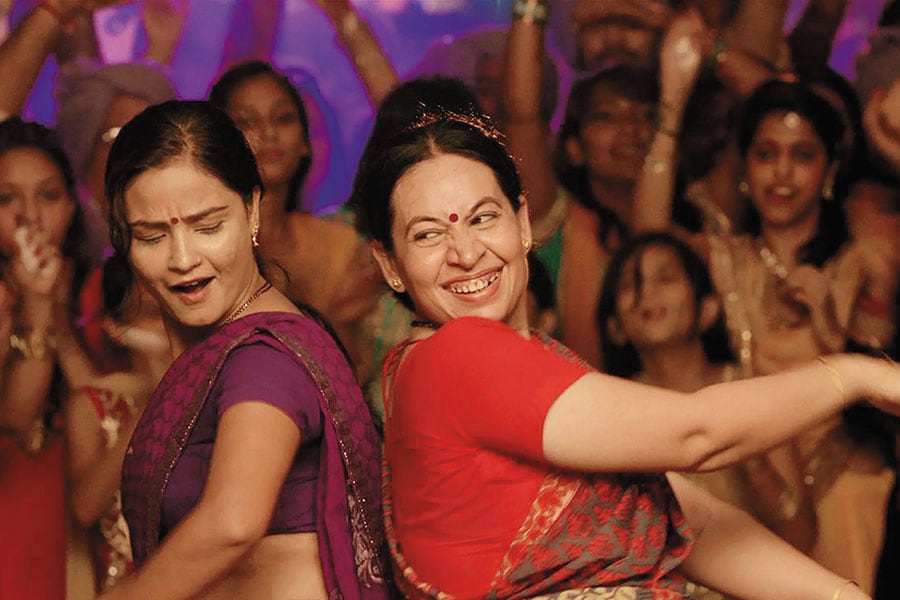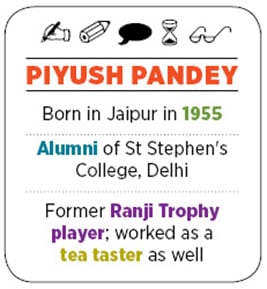Ab ki baar Pandey sarkar
Piyush Pandey's elevation as global chief creative officer of Ogilvy—a first for an Indian—underlines how the celebrated adman transformed the iconic ad agency from multinational to multicultural


 Image: Mexy Xavier
Image: Mexy Xavier
The only sound in Pandey’s living room emanates from his television set. An Aussie victory would end the country’s losing streak of five Test matches. A win for India would script history of a different kind: Its first Test victory in Australia since 2008.
With Australia just 32 runs away from victory and the contest getting intense with every passing minute, Pandey appears tense on a chilly December morning. He lights a cigarette, the smoke adding to the palpable tension in the room. Keeping him company in a corner of an adjacent room is an old cricket bat branded ‘Four Square’. Six colourful hats, like prized trophies, are neatly placed in two vertical rows on the right wall as one enters his flat. A huge portrait of Pandey’s mother, along with a small, multi-headed idol of Lord Ganesha, is on the other side of the room. On one of the walls hangs a row of antique wall clocks, each showing different international time zones.
Meanwhile in Adelaide, Hazlewood edges a low catch to second slip. India win. Pandey exults. “They (Indian team) fought like maniacs,” says the former Ranji player for Rajasthan. “I had predicted a 68-run victory and was tense in the last 45 minutes,” says Pandey, 63, with a wide grin that stretches his bushy Walrus moustache across his wide jaw.
Dressed in a short-sleeved Hawaiian T-shirt and matching trousers, Pandey lights another cigarette. “It’s a first,” he says, as he takes a long drag. India has never won a series opener Down Under in the 70-year history of Indo-Australian Test cricket. “This is fantastic,” he adds, with child-like excitement, something that’s stayed with the celebrated adman since he joined Ogilvy as a client servicing account executive in 1982. “It’s [the victory] a wonderful thing for the country,” he says.
There’s another equally glorious event but Pandey isn’t as exuberant to talk about that.
In early December, Ogilvy, one of the world’s oldest and largest advertising agencies headquartered in New York and with offices across 83 countries, elevated Pandey as the new worldwide chief creative officer, a first for any Indian. Before his promotion, Pandey was executive chairman and creative director of Ogilvy South Asia.
Ask him more about his new global role, and the witty adman uses a cricket analogy: If you don’t play enough, you can’t be in the team. And if you are not in the team, you can’t be captain. But isn’t he now first among equals? “Being first among equals is a responsibility, not a medal," he says bluntly, much like the manner in which he played a crisp cover drive during his college days. “I was a player in the team, and I will still be a player in the team.” It seems he can’t stay away from the cricketing metaphors. “Cricket is in my blood,” he continues.
Cricket and advertising
Pandey’s tryst with cricket started early, as early as his birth in Jaipur, where his father worked in a state cooperative bank. “We could have formed our own cricket team,” Pandey wrote in his book Pandeymonium, which was published in 2015. The Pandeys are a family of eleven: Seven sisters elder to Piyush, a younger brother, his parents and himself. Ironically, it was Pandey’s cricketer friend Arun Lal who nudged him towards advertising. Before joining Ogilvy in 1982, Pandey worked as a tea taster in Kolkata.
Cricket was not only in his blood but it also turned out to be the creative oxygen that kept him going. Pandey realised it quite early in his advertising career. No wonder, some of his most iconic, and charming, advertisements are woven around the game.
Take, for instance, the Cadbury Dairy Milk commercial in 1994. A young woman celebrates her friend’s match-winning innings by leaping from the stands and dancing on the ground. The advertisement, which had a terrific story line, great music and ended with the tagline 'Asli Swad Zindagi Ka' (the real taste of life), went on to become one of the most memorable ads in Indian advertising.
The commercial got etched in consumers’ consciousness for a myriad of reasons. First, the ad did not talk about the product. In fact, it didn’t sell chocolate at all. Second, a free-spirited dance by the young girl sent an implicit message to society that this was the (early) period of economic liberalisation. It brought women to the centre stage and won their hearts. Third, and most importantly, it forever changed the way Indian advertisements were made. The hitherto English-dominated advertising world was getting the 'asli swad' of connecting with people, and speaking in a language they can relate to.
For Cadbury, the advertisement marked a quantum jump in its positioning on two counts. During the '80s, the MNCs' television campaigns were made in the colonial language. In one stroke, Pandey made the product look Indian by talking to consumers in Hindi. The ad also helped Cadbury break the perception of being branded as a product for children.
Deepak Iyer, managing director of Mondelez India Foods, the makers of Cadbury, contends that campaigns led by Pandey tapped into the rich cultural lexicon of the country and created stories that have stood out for consumers over the years. “The key of our advertising has been to tell a story —of people and relationships—rather than sell a product,” he says. “Piyush has helped us do that wonderfully over the years.” Pandey, he reckons, has been instrumental in building the Cadbury brand in India, right from the trendsetting ‘Kuch Khaas Hain Zindagi Mein’—the girl rushing onto the cricket field without inhibition —to ‘Badhti Dosti Ke Naam, Kuch Meetha Ho Jaaye’ where a mother-in-law and her daughter-in-law form a new bond over celebrating a moment.
Commenting on the long journey that Cadbury has had with Ogilvy, Iyer maintains that the relationship was more of a ‘partnership’ rather than a formal client-agency structure. If Pandey thought of an exciting script, Iyer lets on, he just got on the phone with the marketing head, arranged a meeting to share the idea and in the next few weeks the commercial would be on air. “This shows the deep understanding he has of our brands and the trust we have in him,” adds Iyer.
Pandey’s experiment in 1994 with the cricket theme wasn’t an aberration. It played out multiple times, and quite boldly, over the next decade or so. Take, for instance, the commercials made for the Indian Premier League or his work on the accounts of the franchises of Rajasthan Royals, Mumbai Indians and Deccan Chargers. While Pandey continued with his creativity, he also instilled a new lease of life into categories that were perceived to be ‘untouchables’ because they lacked strong consumer appeal.
Hindi and Humour
For Pidilite, the company that owns Fevicol, Pandey transformed a commodity (adhesive) into a brand with a brilliant mix of humour and Hindi.  David Ogilvy, the founder of Ogilvy, once remarked: The best ideas come as jokes. Make your thinking as funny as possible. Pandey took the advice seriously. Take, for instance, the Fevikwik commercial with a fisherman using a stick with Fevikwik on it. A grim-looking man, sitting alongside, brandishes fancy fishing equipment but fails to get a single catch. The ad made people laugh as well as conveyed the brand proposition—stickiness—through its catchy tagline: 'Chutki Mein Chipkaye'. There was more to follow. 'Chipke Rehna', 'Fevicol Ka Jodd Hai, Tutega Nahin', 'Dum Laga Ke Haisha'. Pandey changed the lingo.
David Ogilvy, the founder of Ogilvy, once remarked: The best ideas come as jokes. Make your thinking as funny as possible. Pandey took the advice seriously. Take, for instance, the Fevikwik commercial with a fisherman using a stick with Fevikwik on it. A grim-looking man, sitting alongside, brandishes fancy fishing equipment but fails to get a single catch. The ad made people laugh as well as conveyed the brand proposition—stickiness—through its catchy tagline: 'Chutki Mein Chipkaye'. There was more to follow. 'Chipke Rehna', 'Fevicol Ka Jodd Hai, Tutega Nahin', 'Dum Laga Ke Haisha'. Pandey changed the lingo.
“Even before 'Make in India', Pandey was the original Make in India guy in terms of using Hindi,” says Bharat Puri, managing director of Pidilite. “He made Indian advertising talk to consumers in their language,” says Puri, who has worked with Pandey at Asian Paints and Cadbury (before it became Mondelez after the global merger with Kraft). His rootedness, Puri explains, in Indian culture, emotion and experience gave him a magical, unique touch.
Recalling his stint at Asian Paints, Puri says the challenge for the paint category as a whole was to build a brand. The tagline then—Celebrate with Asian Paints—didn’t have an emotional connect with consumers. “We needed somebody who lives, thinks and breathes in Hindi,” he recounts. Enters Pandey, who was made copy chief in Indian languages when he was moved from the client serving side to the creative department. In 1987, ‘Celebrate with Asian Paints’ got transformed into ‘Har Khushi Mein Rang Laaye’, which was followed by ‘Mera Waala Blue’ and ‘Har Ghar Kuch Kehta Hai’.
Pandey, reckon brand experts, is the first to break the trend of ‘English-thinking’ ad men. “He in many ways is the first among all classy advertising agency people who glamourised the desi and dehati,” says brand strategist Harish Bijoor. Pandey, he adds, was the first of the HMTs (Hindi Medium Types), something which was then derided in the world of business, marketing and advertising. When everyone else was besotted with 'English', 'Western' and rolling of the Rs and the Ps, Pandey was doing something else. “He Indianised with passion,” says Bijoor. The advertising agency that was built around Piyush looked different from others. “Diversity was encouraged and the 'desi' was celebrated.”
In Pandeymonium, Pandey wrote about the need for ‘multinational’ companies to become ‘multicultural’. “Ogilvy is multicultural… which is a statement of humility. Multicultural means the company is not the king, the consumer is the king,” he wrote. “Ogilvy is in my blood.”  A recent Cadbury ad in which a mother-in-law and daughter-in-law dance on the streets
A recent Cadbury ad in which a mother-in-law and daughter-in-law dance on the streets
Sitting relaxed in his Mumbai house, Pandey says that while products are made in factories, brands are made in the hearts of people. A slew of concurrent events, during the late '80s, made people start taking notice of the man from Jaipur. The first was 'Mile Sur Mera Tumhara' in 1988. Created by Suresh Malliick, the lyrics of this advertisement for national integration were penned by Pandey. Then came ‘Chal Meri Luna’ for the moped brand Luna. “People found the commercial refreshing and entertaining,” he says, adding that he started getting noticed within the organisation. “There are no turning points. It’s a continuous process,” he adds. In 1994-95, there was another blockbuster from Pandey for Cadbury’s Perk. It had a tagline 'Thodi Si Pet Puja'. Hindi, as a medium of talking to the target audience, was being used lavishly and smartly. “I have used Indian culture. No campaign of mine has Hinglish, a mix of Hindi and English,” he says, adding that bringing about Indianness was not confined to Hindi. For Asian Paints, Malayalam ads were made for Pongal and Bengali commercials were done during Durga Puja. Pandey sounds a word of caution for those using regional languages in commercials. “You have to ensure that what you use is not open to interpretations,” he says. “One has to be careful.”
Pandey is also responsible for some effective social advertising, including campaigns for polio eradication, anti-domestic violence (‘Bell Bajao’) and anti-smoking for the Cancer Patients Aid Association (CPAA). For a man who was instrumental in shaping the successful political campaign of the Narendra Modi-led BJP government in 2014 with the slogan 'Ab Ki Baar Modi Sarkar', is there a need to change to cater to the millennial generation? Pandey doesn’t think so. The core of advertising cannot change, mediums might vary. "My mother would have said the same things about me when I was 20. The only difference was the absence of the word millennial at that time,” he says and breaks into a hearty laugh.
Mother, his biggest influence
While Pandey prefers using cricketing terminology the most, the soul of his advertising is his mother, his biggest inspiration and teacher. Pandey explains his learning. To be able to manage nine children, he emphasises, she must have been a champion HR (human resource) person. “And since each one of us went on to do some great creative work, it shows that our mother must have been a great creative director,” he says, adding that to manage such a big family on a shoestring budget of a middle-class household also made his mother an expert finance officer.
Cricket, humour, a slice of life and inspiration from family members get reflected in Pandey’s work. Take, for instance, the Bournvita commercial, which revolves around how a mother is there to inspire, encourage and bring out the best in her child.
An ad for SBI Life Insurance is inspired by Pandey’s mother. When Pandey and his younger brother gifted a diamond to their mother, she replied: "Is umar mein main kahan pahenungi heera (where will I wear diamonds at this age?)." Pandey was quick to look for a fitting reply, but in the form of a commercial. An elderly man, in the SBI Life Insurance commercial, gifts a pair of diamond studs to his wife, who asks the same question. The man replied: "Heere ko kya pata tumhari umar kya hai (how do the diamonds know how old you are?)?"
There’s another lift from his real-life experience. The campaign for Pond’s commercial—'Woogli Woogli Wush'—was inspired from what Pandey’s wife Nita told him one day. She grabbed Pandey’s cheeks and said those three words. “The Pond’s campaign with this tagline ran for 10 years,” grins Pandey.
So would the new role as a global chief creative officer change anything in his life? Pandey insists nothing would change. “I have enjoyed the game so far, and that’s what I will continue to do,” he says. Praising his global team, he maintains that the task is to work together in partnership and keep churning out amazing creative stuff. “They (global team members) are all rockstars in their countries. It’s time to continue with the innings,” he says, lighting another cigarette. So how many of his career breaks does he attribute to luck. Perhaps a lot of them. But that’s not important. What is important is that “you need to buy a lottery ticket to be lucky”, signs off Pandey with his signature boisterous laugh.
First Published: Dec 20, 2018, 11:48
Subscribe Now
